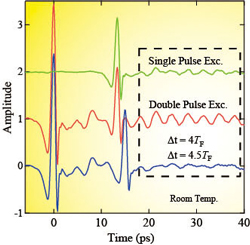Ultrafast Coherent Control of Spin Precession Motion by Terahertz Magnetic Pulses
Suemoto Group
Ultrafast optical coherent control of the spin degrees of freedom is currently receiving intense attention. Preceding reports on demonstrations of coherently controlling the spin systems have been conducted using indirect excitations of the spins that occur as a result of dielectric interaction with optical pulses such as electronic excitations and inverse Faraday effect. Detecting methods of the spin precessions in these studies are generally also indirect and monitor the spins through fluctuation of dielectric constants. Very recently, we succeeded to show that spin precessions are directly excited by magnetic field of a terahertz pulse and observed in time domain via terahertz (THz) emission with a circular polarization from the spin system [1]. In this report, we will demonstrate coherent control of spin precession motions in canted antiferromagnet YFeO3 by the double pulse excitation technique using impulsive magnetic fields [2].

Fig.1. Illustration showing the dynamics of magnetic moment. (a) The magnetic moment is tilted within y-z plane by the impulsive magnetic field by the first pulse along x-axis (blue arrow), and begins precession motion around z-axis. (b) Inserting the second magnetic pulse, the precession of the magnetic moment stops and the moment is directed along z-axis.

Fig.2. Temporal waveforms of transmitted THz wave through c-cut plane parallel plate of YFeO3 for single (green curve) and double pulse (red and blue curves) excitation. The waveforms consist of the half-cycle THz main pulse and oscillation components which reflect the spin precession motion.
As shown in Fig.1, the magnetic moment experiences a force which equals to the cross product of the magnetic moment and the impulsive magnetic field (HTHz) by a first pulse, and is tilted. After this tipping, the magnetic moment starts to precess around the effective magnetic field in the z-axis direction (Fig. 1(a)). The induced precessions of the spins are expected to radiate free induction decay (FID) signal as a circularly polarized electromagnetic wave with a frequency equal to the precession frequency, which persists within the transverse relaxation time. Furthermore, inserting the second magnetic pulse with the appropriate time interval as shown in Fig.1(b), the rotated magnetic moment stops and the moment is directed along z-axis. The magnetic component of the THz pulse with a half-cycled waveform can be regarded as an ultrashort magnetic pulse with the pulse duration of ~ 0.3 ps. We can probe the motion of the magnetic moment by observing the THz emission from the magnetic moment.
Figure 2 shows the experimental result of THz waveforms transmitted through the sample with single and double pulse excitations. The waveforms consist of the half-cycle THz main pulse and oscillation components by the spin precessions due to the ferromagnetic resonance (the oscillation period is TF ~ 3.3 ps or the frequency is 0.299 THz). The oscillation decays by the FID radiation and other relaxation processes within the condensed matter. The oscillation amplitude after the second main pulse for double pulse excitation is enhanced at dt = 4TF (red curve). On the other hand, the oscillation amplitude for dt = 4.5TF (blue curve) are cancelled perfectly. These facts indicate that we succeeded in the coherent control of the spin precession by the ultrashort magnetic pulses and the amplitude can be controlled by only the time interval of the THz magnetic pulses. In the case of dt = 4TF, the amplitude is increased twice, i.e., the stored energy of the spin precession is four times larger. In the case of dt = 4.5TF, the amplitudes becomes zero and the energy of the spin system given by the first pulse is transferred back to the second THz pulse. We demonstrated the ultrafast coherent control of spin precession motion by the impulsive magnetic field for the first time. This technique opens up the possibility of new application for the spin control in the field of quantum information and spintronics, because the effective usage of THz magnetic pulses enable us to observe directly the response of the magnetic dipole transition and to control the spin system with several orders lower energy compared to that in the preceding studies using optical pulses.
References
- M. Nakajima, A. Namai, S. Ohkoshi, and T. Suemoto, Opt. Exp. 18, 18260 (2010).
- K. Yamaguchi, M. Nakajima, and T. Suemoto, Phys. Rev. Lett. 105, 237201 (2010).
